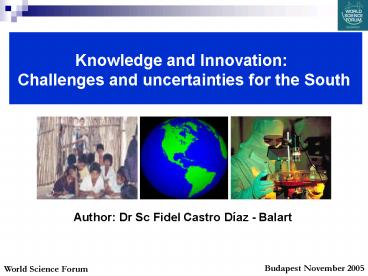Author: Dr Sc Fidel Castro D - PowerPoint PPT Presentation
Title:
Author: Dr Sc Fidel Castro D
Description:
Knowledge and Innovation: Challenges and uncertainties for the South Author: Dr Sc Fidel Castro D az - Balart Budapest November 2005 World Science Forum – PowerPoint PPT presentation
Number of Views:81
Avg rating:3.0/5.0
Title: Author: Dr Sc Fidel Castro D
1
Knowledge and Innovation Challenges and
uncertainties for the South
Author Dr Sc Fidel Castro Díaz - Balart
Budapest November 2005
World Science Forum
2
- The knowledge Economy, in the context of other
issues relevant to development and society. - A developing country eager to close the knowledge
divide. The Cuban experience.
3
KEY FEATURES
- The rapid pace of change in specific supporting
technologies (mobile telephony, internet, genetic
engineering, etc) - Knowledge and
- information as the
- principal sources
- of added value
Globalization
KNOWLEDGE ECONOMY
- Highly qualified human resources
- Knowledge as the
- main limiting
- resource
- Entrepreneurial competition
- for innovation, differentiation
- and high standards of excellence
- World wide distribution of goods and services in
real time - Intellectual property protection
4
ECONOMIC WORLD DIVISSION
NORTH - DEVELOPED 20 of World Population - 80
resources
SOUTH - UNDEVELOPED 80 of World Population - 20
resources
North has control of
A) World resources 86 GDP 68
Foreign Investment 71 Trade 82 Export
markets 80 Energy resources
B) KnowledgeInnovation 80 world investment in
RD 2.5 of GDP for ST 93 Internet users 85
Scientific articles 90 Patents
5
Millions of Users
Internet users throughout the World
259.6
302.3
221.4
103.1
108.1
Europe
114.3
North America
19.4
Asia
5.3
13.5
4.5
56.2
Middle East
18.1
Africa
Latin America / Caribbean
16.3
7.6
2000
361
Oceania
TOTAL
2005
889
Dr. Fidel Castro Díaz-Balart
World Science Forum
6
SOLID NORTHERN ECONOMIES vs FRAIL SOUTHERN
ECONOMIES Export Technological Intensity with
respect to with Total Exports
Regions/ Countries 1999-2003 Primary products Products manufac. with natural resources Low and intermediate technology manufac. goods High Tech manufac. goods
NORTH
United States 7.7 12.6 4.6 33.1
EU 6.1 18.6 53.9 21.5
Japan 0.4 7.7 60.2 31.6
SOUTH
LAC 27.3 17.5 38.3 16.9
China 6.2 9.9 61.2 22.7
Thailand 12.3 16.6 40.1 30.9
7
The Biotech Industry Worlwide
- Year 2005, more than
- 4,000 companies
- 300,000 employees
- 370 products in clinical trial phase III
- 200 FDA approved drugs and vaccines
- Revenues
- In 1992 8 Bn USD 2002 50 USD Bn.
USA
EUROPA
94
96
98
94
96
98
ICT Exports, 1996-2003. ( of total)
30
EU
USA
4
Japan
Latin America
and Caribbean
15
East and Southeast
34
Asia
17
Dr. Fidel Castro Díaz-Balart
World Science Forum
8
Intellectual property rights (I) and Brain
drain (II)
- I Trends Technical barriers and privatization
of knowledge. - II The number of professionals living away from
their country of origin grew from 75 x 106 in
1965 to 120 x 106 in 1990 and reached 150 x 106
in 2000. - During the past 40 years
- 33 of qualified African professionalsimmigrated
to Europe. - 1.1 x 106 Latin American scientist and
researchers immigrated to industrialized
countries which is equivalent to a transfer of 3
billions US Dollars.
9
Bridging the knowledge - divide
The Cuban Experience
10
Higher Education in Cuba
64
Universities, Institutions and University
Graduates
28
3
From 1959 to 2004 more than 750 000 graduates
in
Education 37.6
Others 8
Medical Sciences 16
- Sciences
- Social / Humanities
- Natural / Exact
- Technical/Agricultural/Econ.
38
Dr. Fidel Castro Díaz-Balart
World Science Forum
11
University of Informatic Sciences
- Innovative university for scientific,
- academic and productive excellence, that
- forms professionals mainly for the software
- Industry.
- With
- 8000 students and 700 professors.
- A high technological installed capacity.
- Links with the Cuban enterprise system.
- Production based learning process.
Dr. Fidel Castro Díaz-Balart
World Science Forum
12
- Investment In 2004 1.75 of its GNP for
research activities 0.82 directly to RD - There are 15 scientists and engineers working in
the science and technology sector per 1000
economically active inhabitants.
Science and Technology in Cuba
- Institutions 218 institutions, 118 are research
centres. - Staff
- 31,400 persons work in these institutions, women
represent the 52 of the total labor force
13
West Havana Scientific Pole
NEUROSCIENCES
CIGB
CIM
I. FINLAY
CNIC
CENPALAB
14
The Biotechnology and Pharmaceutical Industry
Strategic concepts for building a
biotechnology sector
Closed loop organizations.
Export oriented organization
Building of an Intellectual
Property platform.
A tight relationship between
research and the industrial strategy
15
Factors contributing to success in Cuba
- Strong
- science base
8. Soft factors Human resources of
excellence
7. ST strategies coherent with national
interests
6. Technology transfer
Education, sciencetech.
5. Created similar to ST parks in Biotech and
ICT
4. Instituting Networking Co-operation
3. Capacity building of a critical mass of
educational and RD institutions and its legal
frameworks
2. Developed a national education programme
Dr. Fidel Castro Díaz-Balart
World Science Forum
16
CONCLUDING REMARKS
- polarization of science is not only a problem in
itself, but also jeopardizes the emergence of
viable solutions to other. - The ability to use knowledge is increasingly
linked to the ability to generate it. - science benefits from diversity of approaches to
a given problem - North-South scientific cooperation as a form of
aid to developing countries, rather than as a
joint approach to global problems that affect
everyone - ST development in Cuba, steams from Jose Marti
central ideas To be free, first be educated
17
THANK VERY MUCH FOR YOUR ATTENTION
Dr. Fidel Castro Díaz-Balart
World Science Forum







![Download [PDF] Talking to Strangers: What We Should Know Abo PowerPoint PPT Presentation](https://s3.amazonaws.com/images.powershow.com/10084662.th0.jpg?_=20240724078)























